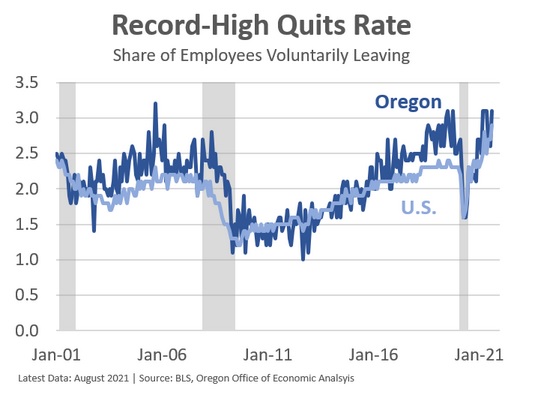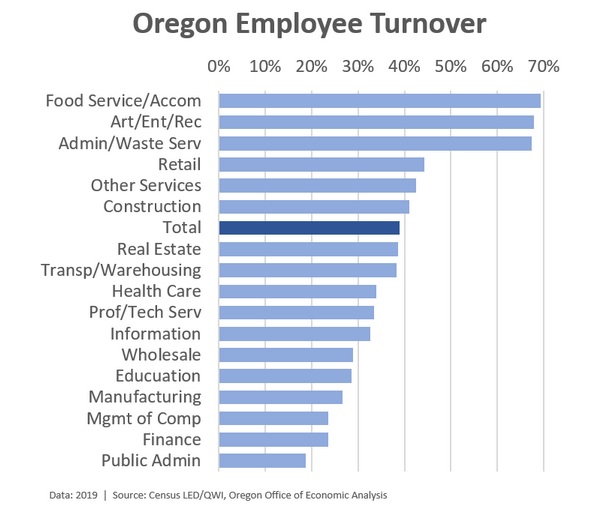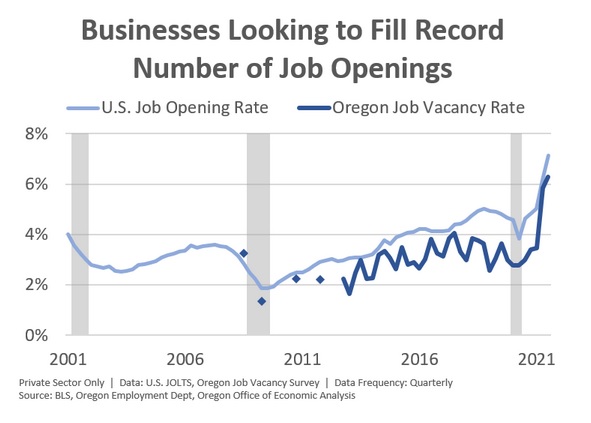
By Josh Lehner
Oregon Office of Economic Analysis,
The labor market is tight. Our office remains labor supply optimists in that workers will return in greater numbers in the months ahead. However with wages booming, this process may take longer than anticipated or be more of a steady stream versus a sudden rush. Even then, the labor market will remain tight for cyclical and structural reasons, it just won’t be acutely tight.
So what are businesses to do? Recently I chatted with the Springfield Chamber of Commerce on the workforce outlook. I hit on four main themes. Raise wages and/or increase flexibility. Increase productivity to offset fewer workers and/or higher labor costs. Tap into the latent labor force where there are tens of thousands of underutilized workers already living in our communities. Firms need to cast a wider net to draw in such individuals. Today, I wanted to highlight the fourth topic: workforce turnover.
But first, our friends over at the Employment Department recently released their latest job vacancy survey data. Oregon businesses are currently hiring for more than 100,000 positions. 78% of these vacancies are difficult to fill, a record. Firms are looking to staff back up as quickly as possible given strong household incomes and consumer demand.
Now, one big challenge firms face is employee retention. Workforce turnover is roughly 40% in any given year. That means there are a lot of bodies coming through the door and a lot of bodies leaving for whatever reason. The exact dynamics here vary by industry as seen below. Many of the sectors experiencing the most difficulty hiring today also experience the highest turnover rates in general.
Besides this general workforce churn, a complicating factor today is the record number of workers quitting their jobs. This increases the need for recruitment and also exacerbates the number of job openings businesses are looking to fill.
Research shows that the majority of these quits are workers leaving for another job, presumably a better opportunity. The job-switching rates are highest, and rising the most for workers without college degrees, and in lower-wage industries. Economically, we hope this results in a better labor match in terms of skills, hours, location, pay and the like. Plus if we are reallocating labor from lower-productivity sectors to higher ones, that will provide longer-term boosts to growth. But even if it’s more about taking advantage of signing bonuses and higher wages from competitors, that will raise household incomes in the lower parts of the distribution.
So why do workers quit? There is no single answer for most people, but in a study I read recently but cannot find a link to, it did show some differences between how workers and businesses think about quits. On the business side, they focus primarily on the hard math — wages, hours worked, etc. For workers, those certainly matter, but what also mattered are the harder to measure things like feeling valued, feeling that their job was worth doing, and having a good manager. While it can be harder to interpret feelings than numbers, the last item — having a good manager — crops up repeatedly across studies and surveys. We cannot see employee-supervisor relationships in the standard economic data, but they matter considerably for employee satisfaction, and for turnover.
Bottom Line: In a tight labor market, employee retention is even more important. There is a lot more workforce turnover than many people realize, so the challenges aren’t just warm bodies through the door, but retaining the workers businesses do have. Some of this comes down to the cold math. Starting wages today are essentially equal to median wages in Before Times for many of these sectors (manufacturing included, not just leisure and hospitality). But some of this comes down to harder-to-measure intangibles like workplace relationships.
Disclaimer: Articles featured on Oregon Report are the creation, responsibility and opinion of the authoring individual or organization which is featured at the top of every article.



